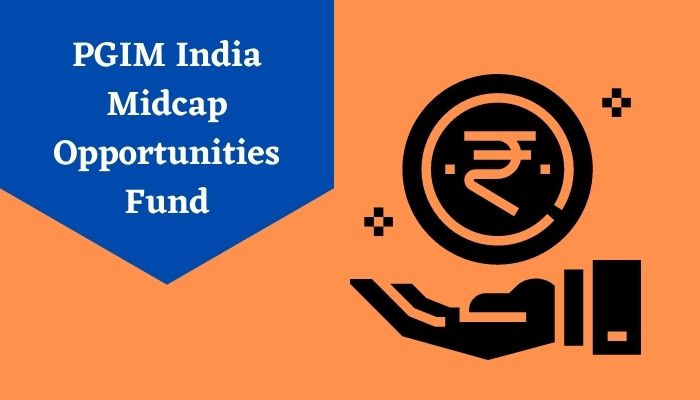PGIM India Midcap Opportunities Fund
PGIM India Midcap Opportunities Fund is an open-ended equity scheme that invests primarily in mid-cap stocks. Being a mid-cap fund, it gives higher returns compared to large caps because mid-cap companies have the growth potential to become large caps in future and this transition journey yields high returns.

The fund is less volatile and has a lower risk compared to small caps because mid-caps have a stronger balance sheet than a small-cap company.
Investment Objective
The scheme invests in equity and equity-related instruments of mid-cap companies to achieve long-term capital appreciation.
Investment Strategy
- The fund identifies quality mid-cap stocks which can grow in a favourable economic environment.
- The scheme has at least 65% of its investments in mid-cap companies and the rest 35% in other company stocks and debt and money market instruments.
- The fund invests in mid-cap stocks according to the investment objective and asset allocation. The fund managers shortlist stocks based on top-down, bottom-up and stock-by-stock approaches. Valuation Parameters like growth, margins, asset returns and cash flows are also considered while making the selection.
- Stocks are selected based on many other factors like
-
- the historical and current financial condition of the company,
- potential value creation and its impact on earnings growth,
- capital structure,
- business prospects,
- responsiveness to business conditions,
- policy environment,
- strength of management,
- product profile and brand equity,
- market share and competitive edge,
- research
Portfolio Composition
PGIM Midcap Opportunities Fund has three categories of companies in its portfolio.
- Stable Growth – Top 40-45% of companies with stable growth
- High Growth – Middle 40-45% companies with strong earnings growth
- Turnaround – Bottom 10-20% companies in bad phase but with good alpha generation potential.
Top Sectors Allocated(% to Net Assets)
Software – 13.28% Banks – 9.18%
Industrial products – 11.82% Pharmaceuticals – 8.51%
Consumer Durables – 9.72% Cement & Cement Products 6.92%
Top 10 Holdings(% to Net Assets)
Timken India Ltd. 3.46 ICICI Bank Ltd. 2.94
Mphasis Ltd. 3.29 Sano India Ltd. 2.89
Coforge Ltd. 3.27 The Federal Bank Ltd. 2.86
ABB India Ltd. 3.18 Sobha Ltd. 2.73
Max Financial Services Ltd. 2.99 Ashok Leyland Ltd. 2.64
Risk Measures
Standard Deviation of Fund (Annual): 18.11%,
Beta: 0.87
Sharpe Ratio: 0.69
Fund Facts
| Inception Date | 02/12/2013 |
| Benchmark | Nifty Midcap 150 TR Index |
| Application Amount | Rs. 5000 |
| Min SIP Amount | Rs. 1000 (minimum 5 installments) |
| Number of stocks | 50 |
| Asset Allocation | Large caps (1st-100th stock) 3.9%
Mid caps (101st-250th stock) 72.0% Small caps (251st stock onwards) 21.7% Cash 2.4% |
| Option | IDCW(Income Distribution cum Capital Withdrawal)Payout /Reinvestment
Growth. |
| NAV(Rs) | PGIM Mid Cap Opportunities Fund Regular Growth – 42.22, IDCW – 23.31
PGIM Mid Cap Opportunities Fund Direct Growth – 46.51, IDCW – 38.55 |
| AUM | Rs 3584.78 crore |
| Expense Ratio | Regular Plan: 2.17%, Direct Plan: 0.32% |
| Portfolio Turnover | 1.17 |
| Exit Load | 0.5% if more than 10% of the units allotted are redeemed within 90 days and Nil if redeemed after 90 days |
| Degree of Risk | Very High |
| Fund manager | Mr. Aniruddha Naha, Mr. Vivek Sharma & Mr. Kunal Jain |
Fund Performance
| PGIM Mid Cap Opportunities Fund | |||
| Period | CAGR Returns (%) | ||
| Fund | Benchmark | ||
| PGIM India Mid Cap Opportunities Fund Regular Growth Plan | |||
| Last 1 Year | 65.63 | 51.90 | |
| Last 3 Years | 33.89 | 20.36 | |
| Last 5 Years | 21.62 | 15.95 | |
| Since Inception | 19.73 | 19.58 | |
| PGIM India Mid Cap Opportunities Fund Direct-Growth Plan | |||
| Last 1 Year | 68.88 | 51.90 | |
| Last 3 Years | 36.20 | 20.36 | |
| Last 5 Years | 23.62 | 15.95 | |
| Since Inception | 21.18 | 19.58 | |
Key Ratios to Analyse a Mutual Fund
- Expense Ratio – It is the cost of managing the fund charged by the mutual fund. It includes operating costs, management fees, allocation charges, advertising costs. Its value is inversely proportional to the size of the mutual fund. A higher expense ratio means a high portion of the return on investment being used to manage expenses, thus reducing the return.
- Portfolio Turnover Ratio – It measures how many times the assets under the fund were traded over a given period. This ratio depends on the market conditions and fund management style. A high value means frequent trading and higher transaction cost, resulting in reduced returns. It also generates higher taxes.
- Beta – It determines how volatile a fund is compared to a benchmark. It measures the risk involved in a fund. If its value is more than one, then it loses or gains more than the benchmark. If the value is one, it is the same as a benchmark and if its value is less than one, its losses or gains are less than the benchmark.
- Sharpe Ratio – It gives the risk-adjusted return on investment. It is calculated by deducting the risk-free return from the portfolio return and dividing it by standard deviation. So it tells the excess return we get on taking the risk involved in the unit. So a high Sharpe ratio means the better yielding capacity of the fund.
- Standard Deviation – It is a measurement of variance from the average. A greater standard deviation means higher volatility, either above or below the average.
Conclusion
Investing in mutual funds is not easy if you don’t understand the financial jargon. PGIM India mutual fund makes the investment process easier for you. It offers the best funds with expert advice on your investments.





























